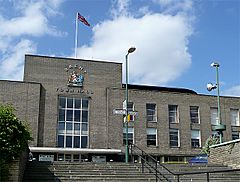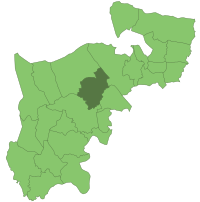Municipal Borough of Wembley facts for kids
Quick facts for kids Wembley |
|
| Motto: Tempori Parendum (We must move with the times) | |
 Former Brent Town Hall in Wembley |
|
 Wembley within Middlesex in 1961 |
|
| Geography | |
| Status | Urban district (until 1937) Municipal borough (from 1937) |
| HQ | Brent Town Hall |
| History | |
| Created | 1894 |
| Abolished | 1965 |
| Succeeded by | London Borough of Brent |
 |
|
Wembley was once a special local area in Middlesex, England. It started as an "urban district" in 1894. Later, in 1937, it became a "municipal borough." Think of these as different types of local governments that managed the area. Wembley existed in this way until 1965.
Contents
A Look Back at Wembley's Local Government
How Wembley's District Began
The Wembley Urban District was created in 1894. This happened because of a new law called the Local Government Act. Before this, Wembley was part of a larger "sanitary district" that looked after public health.
When it first started, the Wembley Urban District included two main areas: Kingsbury and Wembley itself. The Wembley area was made up of smaller places like Alperton, south Kenton, Preston, Sudbury, and Wembley.
The local government for this district was called the urban district council. It had twelve people, known as "councillors," who were elected to make decisions for the area. Nine councillors represented Wembley, and three represented Kingsbury.
Changes Over the Years
In 1900, Kingsbury became its own separate urban district. This meant Wembley's council became smaller, with only nine councillors.
Later, in 1927, the Wembley urban district was divided into six smaller areas called "wards." These wards were Alperton, Sudbury, Kenton, Wembley Central, Wembley Hill, and Wembley Park. Each ward had its own elected representatives, and the total number of councillors grew to 21.
A big change happened in 1934. Kingsbury Urban District joined with Wembley Urban District. This made Wembley much larger. The new, bigger Wembley Urban District then had 12 wards. Eight of these wards came from the original Wembley area, and four came from the Kingsbury area.
Becoming a Municipal Borough
In 1937, Wembley got a special honor: it became a "municipal borough." This meant it had more power to manage its own affairs. A new type of local government was set up. It included a "mayor," who was the head of the council, plus 12 "aldermen" and 36 "councillors." These people worked together to run the borough.
Wembley also received its own special symbol, called a "coat of arms," on January 25, 1938. The coat of arms had a green shield, which showed how green the area was. Two lions stood on either side of the shield. These lions represented John Lyon, who founded Harrow School and lived in Preston Manor in Wembley. Each lion held a flag. One flag showed a balance, which stands for fairness. The other flag showed a "cornucopia," or horn of plenty, which means lots of good things. Above the shield was a crown, and below it was a banner with the Latin words "Tempori Parendvm." This motto means "We must move with the times."
Wembley's End and New Beginning
The Municipal Borough of Wembley stopped existing in 1965. This was due to a new law called the London Government Act 1963. Wembley's area then joined with the nearby Municipal Borough of Willesden. Together, they formed a new, larger area called the London Borough of Brent.
The building known as Brent Town Hall was originally built for the Municipal Borough of Wembley in the late 1930s.

